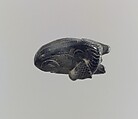Reclining calf: lid attachment
Not on view
This small ivory figurine depicting a resting calf was probably blackened through exposure to fire when the palace complexes at Nimrud were sacked during the final defeat of Assyria at the end of the seventh century B.C. The bottom of the figurine is flattened and has a rectangular hole, into which a peg could be inserted as a means to attach the calf to another object. It was likely attached to the lid of a pyxis, a small round box used for precious goods including luxurious commodities such as spices, incense, cosmetics, perfumes or ointments. A fragment of such a lid, decorated with attached ivory calves and flower buds, was found in the Burnt Palace, where this calf was excavated, along with several additional calves with markings similar to this one. Another ivory lid from the Burnt Palace, which is carved with a rosette in relief and drilled with dowel holes used to attach elements, is in the collection of the Metropolitan Museum (54.117.9).
Built by the Assyrian king Ashurnasirpal II, the palaces and storerooms of Nimrud housed thousands of pieces of carved ivory. Most of the ivories served as furniture inlays or small precious objects such as boxes. While some of them were carved in the same style as the large Assyrian reliefs lining the walls of the Northwest Palace, the majority of the ivories display images and styles related to the arts of North Syria and the Phoenician city-states. Phoenician style ivories are distinguished by their use of imagery related to Egyptian art, such as sphinxes and figures wearing pharaonic crowns, and the use of elaborate carving techniques such as openwork and colored glass inlay. North Syrian style ivories tend to depict stockier figures in more dynamic compositions, carved as solid plaques with fewer added decorative elements. However, some pieces do not fit easily into any of these three styles. Most of the ivories were probably collected by the Assyrian kings as tribute from vassal states, and as booty from conquered enemies, while some may have been manufactured in workshops at Nimrud. The ivory tusks that provided the raw material for these objects were almost certainly from African elephants, imported from lands south of Egypt, although elephants did inhabit several river valleys in Syria until they were hunted to extinction by the end of the eighth century B.C.
Due to rights restrictions, this image cannot be enlarged, viewed at full screen, or downloaded.

